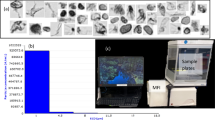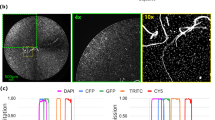Abstract
Quantification of subvisible particles, which are generally defined as those ranging in size from 2 to 100 µm, is important as critical characteristics for biopharmaceutical formulation development. Micro Flow Imaging (MFI) provides quantifiable morphological parameters to study both the size and type of subvisible particles, including proteinaceous particles as well as non-proteinaceous features incl. silicone oil droplets, air bubble droplets, etc., thus enabling quantitative and categorical particle attribute reporting for quality control. However, limitations in routine MFI image analysis can hinder accurate subvisible particle classification. In this work, we custom-built a subvisible particle-aware Convolutional Neural Network, SVNet, which has a very small computational footprint, and achieves comparable performance to prior state-of-art image classification models. SVNet significantly improves upon current standard operating procedures for subvisible particulate assessments as confirmed by thorough real-world validation studies.





Similar content being viewed by others
References
Zolls S, Tantipolphan R, Wiggenhorn M, Winter G, Jiskoot W, Friess W, Hawe A. Particles in therapeutic protein formulations, Part 1: Overview of analytical methods. J Pharm Sci. 2012;101(3):914–35.
Sanchez-Felix M, Burke M, Chen HH, Patterson C, Mittal S. Predicting bioavailability of monoclonal antibodies after subcutaneous administration: Open innovation challenge. Adv Drug Deliver Rev. 2020;167:66–77.
Corvari V, Narhi LO, Spitznagel TM, Afonina N, Cao S, Cash P, Cecchini I, DeFelippis MR, Garidel P, Herre A, Koulov AV, Lubiniecki T, Mahler HC, Mangiagalli P, Nesta D, Perez-Ramirez B, Polozova A, Rossi M, Schmidt R, Simler R, Singh S, Weiskopf A, Wuchner K. Subvisible (2–100 mu m) particle analysis during biotherapeutic drug product development: Part 2, experience with the application of subvisible particle analysis. Biologicals. 2015;43(6):457–73.
Narhi LO, Corvari V, Ripple DC, Afonina N, Cecchini I, Defelippis MR, Garidel P, Herre A, Koulov AV, Lubiniecki T, Mahler HC, Mangiagalli P, Nesta D, Perez-Ramirez B, Polozova A, Rossi M, Schmidt R, Simler R, Singh S, Spitznagel TM, Weiskopf A, Wuchner K. Subvisible (2–100 mu m) particle analysis during biotherapeutic drug product development: part 1, considerations and strategy. J Pharm Sci. 2015;104(6):1899–908.
Carpenter JF, Randolph TW, Jiskoot W, Crommelin DJA, Middaugh CR, Winter G, Fan YX, Kirshner S, Verthelyi D, Kozlowski S, Clouse KA, Swann PG, Rosenberg A, Cherney B. Overlooking subvisible particles in therapeutic protein products: gaps that may compromise product quality. J Pharm Sci. 2009;98(4):1201–5.
Singh SK, Afonina N, Awwad M, Bechtold-Peters K, Blue JT, Chou D, Cromwell M, Krause HJ, Mahler HC, Meyer BK, Narhi L, Nesta DP, Spitznagel T. An industry perspective on the monitoring of subvisible particles as a quality attribute for protein therapeutics. J Pharm Sci. 2010;99(8):3302–21.
Gross-Rother J, Blech M, Preis E, Bakowsky U, Garidel P. Particle detection and characterization for biopharmaceutical applications: current principles of established and alternative techniques. Pharmaceutics 2020; 12(11).
Vargo KB, Stahl P, Hwang B, Hwang E, Giordano D, Randolph P, Celentano C, Hepler R, Amin K. Surfactant impact on interfacial protein aggregation and utilization of surface tension to predict surfactant requirements for biological formulations. Mol Pharm. 2021;18(1):148–57.
Scherer TM, Leung S, Owyang L, Shire SJ. Issues and challenges of subvisible and submicron particulate analysis in protein solutions. Aaps J. 2012;14(2):236–43.
Alzubaidi L, Zhang JL, Humaidi AJ, Al-Dujaili A, Duan Y, Al-Shamma O, Santamaria J, Fadhel MA, Al-Amidie M, Farhan L. Review of deep learning: concepts, CNN architectures, challenges, applications, future directions. J Big Data-Ger 2021; 8(1).
Calderon CP, Daniels AL, Randolph TW. Deep convolutional neural network analysis of flow imaging microscopy data to classify subvisible particles in protein formulations. J Pharm Sci. 2018;107(4):999–1008.
Tan M, Le QV. EfficientNet: rethinking model scaling for convolutional neural networks. ArXiv 2019; abs/1905.11946.
Demeule B, Messick S, Shire SJ, Liu J. Characterization of particles in protein solutions: reaching the limits of current technologies. Aaps J. 2010;12(4):708–15.
Sharma DK, King D, Oma P, Merchant C. Micro-flow imaging: flow microscopy applied to sub-visible particulate analysis in protein formulations. Aaps J. 2010;12(3):455–64.
LeCun Y, Bengio Y, Hinton G. Deep learning. Nature. 2015;521(7553):436–44.
Deng J, Dong W, Socher R, Li L-J, Li K, Fei-Fei L. ImageNet: A large-scale hierarchical image database. IEEE Conference on Computer Vision and Pattern Recognition. 2009;2009:248–55.
Simonyan K, Zisserman A. Very Deep Convolutional Networks for Large-Scale Image Recognition. CoRR 2015; abs/1409.1556.
Krizhevsky A, Sutskever I, Hinton GE. ImageNet classification with deep convolutional neural networks. Commun Acm. 2017;60(6):84–90.
Fawcett T. An introduction to ROC analysis. Pattern Recogn Lett. 2006;27(8):861–74.
Kelley HJ. Gradient theory of optimal flight paths. ARS Journal. 1960;30:947–54.
Good IJ. Rational decisions. J Roy Stat Soc: Ser B (Methodol). 1952;14(1):107–14.
Thirumangalathu R, Krishnan S, Ricci MS, Brems DN, Randolph TW, Carpenter JF. Silicone oil- and agitation-induced aggregation of a monoclonal antibody in aqueous solution. J Pharm Sci. 2009;98(9):3167–81.
Jones LS, Kaufmann A, Middaugh CR. Silicone oil induced aggregation of proteins. J Pharm Sci. 2005;94(4):918–27.
Krayukhina E, Tsumoto K, Uchiyama S, Fukui K. Effects of syringe material and silicone oil lubrication on the stability of pharmaceutical proteins. J Pharm Sci. 2015;104(2):527–35.
Joh NH, Thomas L, Christian TR, Verlinsky A, Jiao N, Allotta N, Jawa V, Cao S, Narhi LO, Joubert MK. Silicone oil particles in prefilled syringes with human monoclonal antibody, representative of real-world drug products, did not increase immunogenicity in in vivo and in vitro model systems. J Pharm Sci. 2020;109(1):845–53.
Shi GH, Gopalrathnam G, Shinkle SL, Dong X, Hofer JD, Jensen EC, Rajagopalan N. Impact of drug formulation variables on silicone oil structure and functionality of prefilled syringe system. PDA J Pharm Sci Technol. 2018;72(1):50–61.
Quiroz AR, Lamerz J, Da Cunha T, Boillon A, Adler M, Finkler C, Huwyler J, Schmidt R, Mahler HC, Koulov AV. Factors governing the precision of subvisible particle measurement methods - a case study with a low-concentration therapeutic protein product in a prefilled syringe. Pharm Res-Dordr. 2016;33(2):450–61.
Acknowledgements
We would like to thank Timothy Rhodes, Lei Zhu, Anita Dabbara, Chengbin Huang, and Xi Zhao for discussion and contributions.
Author information
Authors and Affiliations
Corresponding authors
Ethics declarations
Conflicts of Interest/Competing Interests
The authors declare no funding and/or conflicts of interest and/or any other competing interests.
Additional information
Publisher's Note
Springer Nature remains neutral with regard to jurisdictional claims in published maps and institutional affiliations.
Supplementary Information
Below is the link to the electronic supplementary material.
Rights and permissions
Springer Nature or its licensor (e.g. a society or other partner) holds exclusive rights to this article under a publishing agreement with the author(s) or other rightsholder(s); author self-archiving of the accepted manuscript version of this article is solely governed by the terms of such publishing agreement and applicable law.
About this article
Cite this article
Wang, S., Liaw, A., Chen, YM. et al. Convolutional Neural Networks Enable Highly Accurate and Automated Subvisible Particulate Classification of Biopharmaceuticals. Pharm Res 40, 1447–1457 (2023). https://doi.org/10.1007/s11095-022-03438-0
Received:
Accepted:
Published:
Issue Date:
DOI: https://doi.org/10.1007/s11095-022-03438-0




